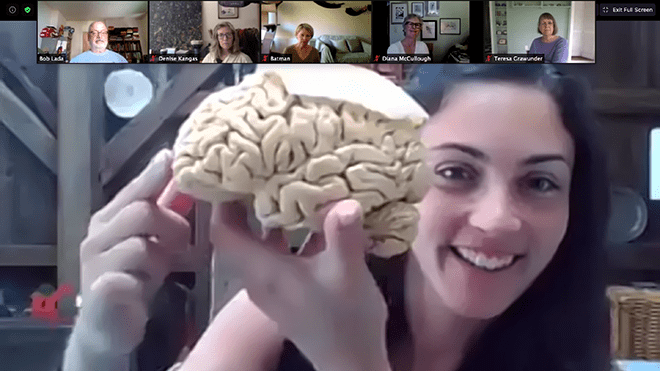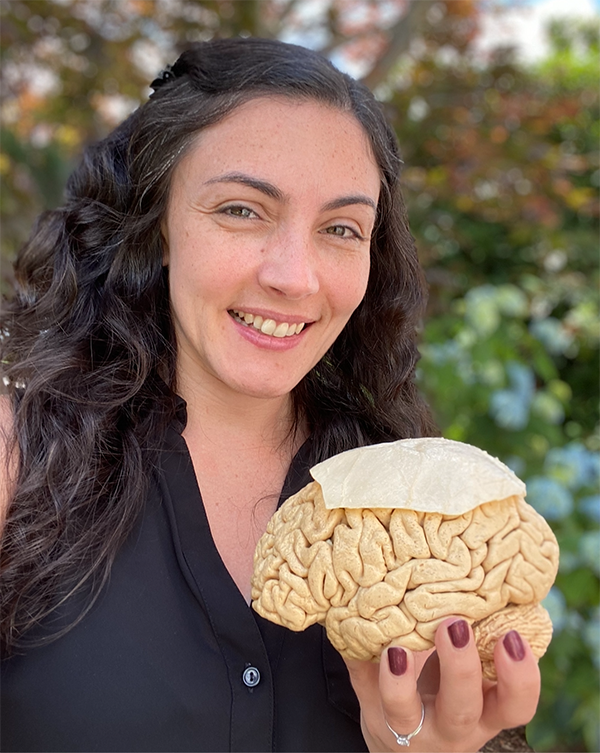Psychology Department Acquires Plasticized Human Brain
RWU is now one of two schools in the state to have a plasticized human brain for neuroscience education

Have you ever held a human brain in your hands? Thanks to RWU’s recent acquisition of a real, plasticized human brain, RWU students will be able to explore the brain’s anatomy through hands-on experience.
Victoria Heimer-McGinn, neuroscientist and Assistant Professor of Psychology at RWU, is the brains behind the brain. She was inspired to include a human brain in her lessons at RWU by her work as co-founder and director of the nonprofit Brain Week Rhode Island.
Heimer-McGinn recently presented the brain at the Annual Alexander Technique Summer Retreat, which traditionally takes place at RWU but was hosted virtually this year. In her presentation, Heimer-McGinn introduced participants to the plasticized brain over Zoom with a neuroscience lesson, then opened the floor to questions.
“Why does the brain have two hemispheres?” “How are musicians able to use their brains to precisely keep time?” “How much space is there between the skull and the brain?”
With the human brain as an impetus for curiosity, the questions flowed, and Heimer-McGinn was ready to answer. We had questions for Heimer-McGinn as well, who recently told us more about the Psychology Department’s new brain.

What is the purpose of this brain?
It’s really hard to teach anatomy of the brain with just a book. With a brain in your hand, all of a sudden, the class is really cool. Students want to come to class. They want to explore the brain, look at it, and wonder about the person it belonged to, their memories and their past. It’s an educational tool and an outreach tool, and I’m hoping that throughout the years we can use it for many other things.
How else do RWU students work with brains?
At Brain Week Rhode Island, we have an educational program where we go into schools – Pre-K to 12th grade – with human brains, and give the kids a fun anatomy lesson centered on the actual human brain. It obviously is ridiculously cool and we have everyone’s attention from the age of 5 to 18. We have a team of Roger Williams students that I have trained to go into classrooms and do this. I’m really excited about the Roger Williams team, because our students are so excited about this. This is a great experience for them to go out and do a lot of community work, which is something Roger Williams really prides itself on.
How is it preserved?
It is plasticized. After it’s removed, the first step is to put it in a formaldehyde solution that preserves it. This is the typical fixation you think of when you think of horror movies and body parts sloshing around in some sort of toxic chemical. What follows next is they immerse it in liquid resin that enters the cells and solidifies, like shellacking your nails. Have you heard of the show Body Worlds? It’s the same technique they use. The great thing about that is you can actually touch the brain without dangerous chemicals getting on your hands, so it really is a great resource.
Is it all in one piece?
Right now, we have a whole brain. These brains are incredibly expensive, which is why it is so exciting that Roger Williams is the second place in the state that has one, actually. The hope is eventually we will get the whole set, but now it is the full brain.
Where did it come from?
You can’t buy one unless you are an academic institution. Human material is very sensitive and not easy to come by. A lot of brains come from Europe or Asia, and there is a really long waiting time and a very high price. We actually got ours from the United States, which we were happy about, since it’s a little more local.
What does this mean for the psychology department?
It gives us the opportunity to grow the neurosciences within the Psychology Department. We are thinking of putting together a Bachelor of Science degree in addition to the Bachelor of Arts degree we currently offer in Psychology, which will include a heavier component of sciences, including Neuroscience. It really echoes how important the neurosciences are becoming for Roger Williams, and that is important because there are a lot of students indicating their interest in neuroscience.